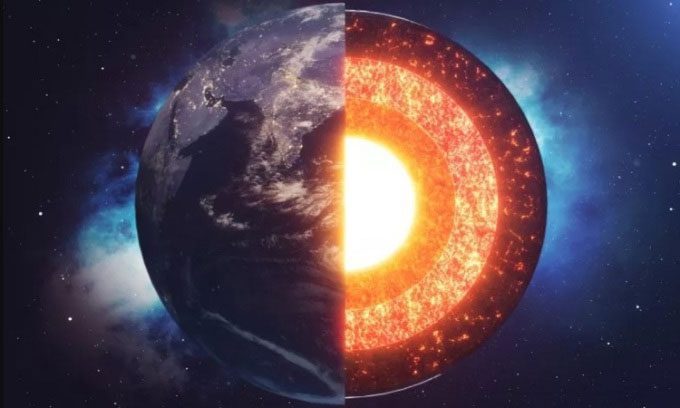A new study published on January 23 in the journal Nature Geoscience reveals that changes in the rotation direction of the Earth’s inner core may occur within the next few decades.
In the mid-1990s, researcher Xiaodong Song at the SinoProbe Laboratory at the School of Earth and Space Sciences at Peking University, China, collaborated with Paul Richards at Columbia University, providing the first evidence of independent rotational motion of the inner core. They found that the inner core rotates from west to east, albeit slightly faster than the other solid layers, such as the mantle and crust. This rotation is primarily influenced by magnetic effects and electrical effects within the surrounding liquid outer core, as well as gravitational interactions with the mantle.

Simulation of Earth’s layered structure. (Photo: iStock)
However, following this discovery, there were still unresolved issues regarding the rotation direction of the inner core when considering factors such as rotation speed. Such issues prompted Song and fellow researcher Yi Yang, also at the SinoProbe Laboratory, to gather additional long-term data to test various models, leading to their latest prediction. In the newly published study, they analyzed seismic waves generated by natural earthquakes, transmitted through the Earth’s core since the 1960s.
“Seismic waves from two repeating earthquakes often have similar waveforms originating from the same station,” the research team stated. “However, when waves from repeating earthquakes interact with the Earth’s inner core, they display different waveforms and arrival times, reflecting different structures within the inner core.”
Using seismic waves, the research team was able to infer the rotation pattern of the inner core over the past few decades, revealing new details about this process and its relationship with other layers of the Earth. Their findings indicate that the inner core has been rotating faster than the mantle and crust from west to east since the early 1970s until around 2009. After that, the rotation seemed to pause from 2009 to 2011. From this period, the rotation appears to have gradually reversed direction. These changes are likely part of a 70-year oscillation.
The Earth consists of several layers. The thin outermost layer is the crust, primarily composed of solid rock, which is about 32 to 48 km thick in continental areas, while in the oceans, the average thickness is about 6.4 km. Beneath the crust is the mantle, approximately 2,900 km thick, accounting for 84% of the Earth’s total volume. This layer includes denser rock material than the crust and is primarily solid, although rock in some regions can melt under high pressure.
Below the mantle is the Earth’s core, divided into the outer core and inner core. The outer core is about 2,253 km thick, predominantly made up of liquid iron and nickel. At the center of the Earth is the inner core, a highly dense solid approximately 1,207 km thick, formed from iron, a small amount of nickel, and many other elements. Two main factors influence the inner core. The first is electromagnetic force. The Earth’s magnetic field is generated by the movement of liquid in the outer core. This magnetic field affects the inner core, causing it to rotate. The other factor affecting the inner core is gravity. The inner core and mantle differ significantly in their physical characteristics, so the gravitational force between the two structures tends to pull the inner core toward a point of equilibrium.
“If the two forces are not balanced, the inner core will either speed up or slow down,” the researchers explained. “The 70-year oscillation of the inner core is likely influenced by electromagnetic and gravitational forces.” This oscillation corresponds to periodic changes in other geophysical observations, such as variations in the magnetic field or the length of the day.
However, Song and his colleagues emphasized that there are some limitations in the study, including the limited availability of seismic data over time. “We have not yet observed a complete cycle of the 70-year oscillation with data collected in less than 60 years. Modern digital seismic stations began to be deployed globally in the 1990s. Much of the ancient seismic data is recorded on paper, but they are quite scarce and difficult to access,” the research team shared.


















































